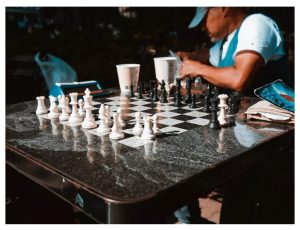CHESS PHOTO: IMPORTANT TIPS FOR A PROFESSIONAL APPROACH
 It would seem that it’s so special in photographing people playing chess. However, if you take chess photography seriously, you can see how exciting it is. In order to convey everything that accompanies chess in a static image, you will need a few tips. Get to know them, and then shooting your first tournament will be awesome by default.
It would seem that it’s so special in photographing people playing chess. However, if you take chess photography seriously, you can see how exciting it is. In order to convey everything that accompanies chess in a static image, you will need a few tips. Get to know them, and then shooting your first tournament will be awesome by default.
Don’t bother the players
Playing chess involves a lot of concentration. As a photographer, you must be careful not to interfere with the process when shooting. Firstly, in order not to distract the players, do not get too close to them. Try to stay at least two meters away if possible. This is enough so that you can shoot high-quality images without interfering.
Chess photography: important tips for a professional approach
Secondly, you need to try to make less noise. The game of chess is much like a golf tournament. Do not talk while people are playing. Just watch and take pictures calmly. Finally, do not move too much. If your location doesn’t seem ideal, go to a better place for a specific purpose. Keep your distance from the players and carefully walk to a place that seems suitable for you. In general, minimize all your movements.
Use the zoom lens to take details
Since you need to keep your distance from the players, it makes sense to use a zoom lens. So you can take close-up or medium shots without having to move too much. Fortunately, you don’t even need an expensive zoom lens to shoot a chess game.
Chess photography: important tips for a professional approach
However, if you shoot all the time in places with poor lighting, use a fixed lens. A great example is the 85mm portrait lens. You can maximize the aperture at around f / 1.8 or even f / 1.4. This is enough for you to shoot without having to increase the ISO too much (we’ll talk about that later). In addition to the aperture, 85 mm also has an ideal focal length for chess photography. Despite the fact that there is no possibility to change the scale, this lens still allows you to take close-up shots of objects, even when you are far from them. And since it refers to portraiture, then the players will also simply come out well in the photo.
Turn on silent mode
Remember the click sound your DSLR or mirrorless camera makes? Sometimes it is so loud that it can distract the players. An easy way to avoid this is to enable Silent Mode. Different manufacturers have different names for Silent Mode. Nikon calls it “Silent mode”, Canon calls it “Silent shutter”, for mirrorless cameras, for example, Sony use the term “Silent shutter”. If you use the silent DSLR mode, you will still hear the shutter click because it takes pictures mechanically. The only difference is that the sound will be more muffled compared to the usual shutter click.
If you use a mirrorless camera, there is a high probability that you will not hear anything at all. The reason is that it does not use mechanical parts in order to take a picture. In many ways, this is the perfect device for shooting a chess tournament.
Chess photography: important tips for a professional approach
Remember that each camera has its own way of activating silent mode, so be sure to read the manual to understand how to use it specifically on your device.
The best settings for chess photography
In addition to activating silent mode, you will also have to adjust the shooting settings.
Chess photography: important tips for a professional approach
ISO is a parameter that is responsible for changing the sensitivity of the camera’s sensor to light. The lowest value is usually 100, which is ideal for use on a sunny day. But if you shoot a chess game in a dark room, this value will not be enough. So gradually increase the ISO value until your photos look right. Just remember to keep it no higher than 800. Otherwise, you can get noticeable noise in the photo.
Then set the aperture priority shooting mode. This will allow you to independently choose the aperture value, and the camera to decide what the shutter speed will be. Stick to f / 1.4 or f / 1.8. This way you can blur the background and isolate the subject from the rest of the scene.
Even when using aperture priority, you still need to monitor the shutter speed. If it falls below 1/60, you run the risk of getting focus blur. To avoid this, increase the ISO or open the aperture to let in more light.




